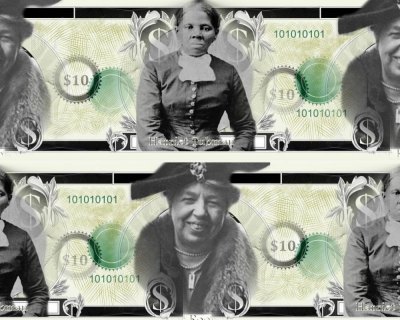U.S. bill will feature a woman, but which one?

The new bill's unveiling will coincide with the 100th anniversary of the 19th Amendment, which gave women the right to vote. The Treasury Department wants public input -- roundtables and town halls and, natch, tweets at #TheNew10.
This has been long coming, and it will be hard to narrow the candidates down. The Treasury Department announcement specifically notes that it is looking for a "champion for our inclusive democracy."
So with that in mind, here are some suggestions to commemorate the right of women to vote:
Sacagawea (1788-1812): The Shoshone woman and her husband, a French Canadian fur trader, acted as interpreters for Meriwether Lewis and William Clark during their 1804-06 expedition. In 1805, the explorers took a vote to decide where they would spend winter. Sacagawea was counted in, along with York, an African-American slave. She is considered the first woman and he the first African-American on the continent to cast a vote.
Susan B. Anthony (1820-1906): Anthony packed much activism into her 86 years of life. While well-known as a suffragette, she also advocated higher wages for teachers and was active in the abolitionist movement. Sadly, she did not live to see women vote in 1920. See the biography on the website for her home.
Jeannette Rankin (1880-1973): A suffragette who became the first woman to serve in Congress, Rankin was controversial. A devout pacifist, she voted against U.S. participation in both world wars, according to her biography on the U.S. House of Representatives website.
Rosa Parks (1913-2005): For many years, Parks was among the most recognizable names of the civil rights movement. A seamstress living in Alabama, she refused to give her bus seat to a white man in 1955. Parks was arrested and convicted of violating segregation (Jim Crow) laws. Her appeal set in motion a successful challenge to segregation. While impressive enough, Parks and her husband also took part in voter registration drives in Alabama, according to the New York Times obituary.
Possibilities commemorating women’s contributions to monetary policy:
Harriet Tubman (approximately 1820-1913): A much-celebrated conductor for the Underground Railroad, Tubman acted as economic change agent for hundreds of families. After escaping slavery, she slipped back into the South to free her sister and her sister’s children, recounts the PBS.org website. But that wasn’t all. She made repeated dips into slave-owning states, eventually freeing an estimated 300 people from slavery. She traveled at night, using the North Star to navigate. (Separately, there have been efforts to have her featured on the $20 bill.)
Frances Perkins (1880-1965; some sources give her year of birth as 1882): Perkins, a graduate of Mount Holyoke College, was Franklin D. Roosevelt's secretary of labor and the first woman to fill a Cabinet post. In that position, she became the principal architect of New Deal legislation. In 1934 Perkins served as chairwoman of the President's Committee on Economic Security. Hearings and reports from the group resulted in the Social Security Act of 1935, according to the Social Security Administration website.
Eleanor Roosevelt (1884-1962): She was the longest serving first lady and an able-bodied representative for her husband, Franklin Delano Roosevelt, stricken with polio. After his death, she became a diplomat. Throughout her life she worked on human rights issues, supporting women’s inclusion in unions, according to Eleanor Roosevelt and the Women’s Movement, on the George Washington University website.
Shirley Chisholm (1924-2005): The first African-American congresswoman, Chisholm was elected in 1968 to represent Brooklyn, N.Y. Fiery and outspoken, she sponsored measures aimed at helping families, championing increases in federal funding to extend the hours of day care facilities and promoting a guaranteed minimum annual income for families, according to the U.S. House of Representatives website.
Sources used in this article:
- U.S. Treasury: Secretary Lew Announces Historic Decision To Feature A Woman On The Newly Redesigned Ten Dollar Note
- U.S. Park Service: Lewis & Clark National Historic Trail, Sacagawea
- Susan B. Anthony House: Biography of Susan B. Anthony
- U.S. House of Representatives website: Jeannette Rankin
- U.S. House of Representatives website: Shirley Chisholm
- Henry Ford Museum: Exhibits, bus in the Rosa Parks case
- The New York Times Obituary: Rosa Parks, 92, Founding Symbol of Civil Rights Movement, Dies
- PBS.org: Harriet Tubman
- Social Security Administration website: Frances Perkins
- Frances Perkins Center.org: Frances Perkins -- The Woman Behind the New Deal
- George Washington University: Biography of Anna Eleanor Roosevelt
Related:
Voting rights-- Past, present and future
If you would like to comment, contact StudyHall.Rocks or like us on Facebook and tell us what you think. Who should be featured on the new $10 bill?

